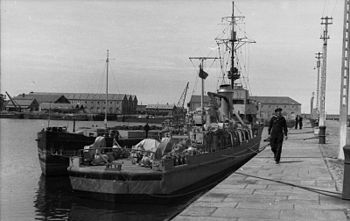Minesweeper 1935
| Minesweeper 1935 | ||
|---|---|---|

|
||
| Class details |
|
|
| Ship type: | Minesweeper 1935 | |
| Period of service: | 1938-1963 | |
| Units: | 69: M 1 - M 39, M 81 - M 85, M 101 - M 104, M 131 - M 133, M 151 - M 156, M 201 - M 206, M 251 - M 256 | |
| Construction costs per unit: | M 1 to 12 each RM 5.5 million, from M 25 each RM 3.5 million | |
| Technical specifications | ||
| Length: | 68.1 m | |
| Width: | 8.7 m | |
| Draft: | 2.7 m | |
| Displacement: |
|
|
| Drive: | 3500 PSi on two shafts
|
|
| Speed: | 18.2 kn | |
| Range: | 5000 nm at 10 kn | |
| Crew: | initially 84, later 120 men | |
| Armament upon commissioning: |
|
|
| Armament in the German Navy: |
|
|
The 1935 minesweeper was a class of minesweeper of the Kriegsmarine .
Development and production
Until the mid-1930s, the Reichsmarine only owned old minesweepers of the type minesweeper 1915 and minesweeper 1916 , which had been built during the First World War or were completed shortly after the end of it. The “Minesweeper 1935” class was developed as a replacement for these boats and built from 1935 onwards at ten different German shipyards. The first boat of the class M 1 , ran on 5 March 1937 by the stack and was put into service on September 1, 1938th From 1938 to 1942 a total of 69 boats of this class were put into service. They were given numbers from M 1 to M 256 (not numbered consecutively). The boats were like their predecessors, very seaworthy and agile and proved themselves in the war and were also considerably improved. However, they were also demanding and expensive to build, which is why the construction of the following class ( minesweeper 1940 ) was simplified to reduce costs and for shorter construction times. Since the machinery was relatively complex and difficult to maintain, and the boilers were oil-fired, there were fuel shortages in the final years of the war. The boats of the 1940 and 1943 classes were therefore again coal-fired.
Boats from M 25 and up that were laid on keel after the start of the war are also called Type 1939 (Mob). They had a crew of 120 men.
use
With their strong armament, the boats of this type were versatile and were used in World War II not only for mine clearance, but also for escort and submarine hunting . In addition, they could lay up to 30 sea mines . It was used in the western, northern and northeastern European waters from the Atlantic coast via the North Sea and the Norwegian Sea to the Baltic Sea.
They were involved in many skirmishes with Allied forces, especially in the area of the English Channel, and were therefore also referred to by the British as " Channel Destroyers ". 32 of the boats were lost in the war. One, M 24 , sank in January 1944 after a mine hit, but was lifted and put back into service.
Use after the war
Many of the 36 boats that were not destroyed in the war were used for mine clearance in the German mine clearance service and in other German sea units under Allied control after 1945 . 14 boats were taken over from the Soviet Union as spoils of war . The British Royal Navy took over nine, two of which they passed on to France . The US took over eight boats, but passed seven of them on to France. France received five boats - plus the nine units ceded by the Royal Navy and the US Navy.
Five of the French-owned boats were bought back by the newly established German Navy in 1956/57 . They were used under the names Wespe (ex M 24), Hummel (ex M 81), Brummer (ex M 85), Biene (ex M 205) and Bremse (ex M 253) as escort boats of class 319 for training purposes until 1963 initially the 1st escort squadron and from 1960 the school squadron of the German Navy.
References
literature
- Siegfried Breyer, Gerhard Koop: The ships and vehicles of the German Federal Navy 1956-1976. Munich 1978, ISBN 3-7637-5155-6 .
- Heinz Ciupa: The German warships 1939-1945. VPM, ISBN 3-8118-1409-5 .
Web links
Footnotes
- ↑ Stülcken-Werft Hamburg, Oderwerke Stettin, Lübecker Maschinenbau Gesellschaft (LMG) Lübeck, Flender-Werke Lübeck, Schichau-Werke Elbing , Atlas-Werke Bremen, Rickmers Werft Wesermünde, Lindenau Werft Memel , AG Neptun Rostock and Deutsche Werft Hamburg.
- ↑ M 1 - M 39, M 81 - M 85, M 101 - M 104, M 131 - M 132, M 151 - M 156, M 201 - M 206, M 251 - M 256
- ^ A b Siegfried Breyer, Gerhard Koop: The ships and vehicles of the German Federal Navy 1956-1976.